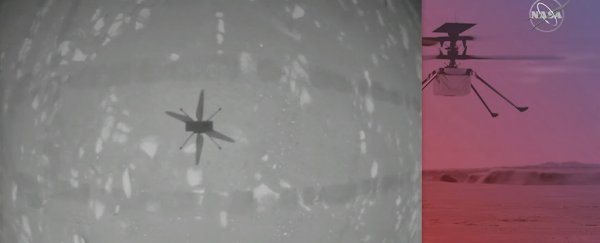Update (19 April): On 19 April 2021, NASA reached a historic milestone - the first-ever controlled flight of a craft in the atmosphere of another planet.
The proof-of-concept flight was performed by the little helicopter called Ingenuity, which hitched a ride to the red planet with the Perseverance rover, landing earlier this year.
"We must take a moment to celebrate this," an ecstatic Ingenuity project manager MiMi Aung congratulated everyone on the team after they received and parsed the initial data, confirming the successful test flight.
A deeper analysis of this monumental achievement is to come during a NASA broadcast at 2 pm EDT, when we will learn more about the altitude, length of the flight, and other details. You can watch that live right here.
"Ingenuity has performed its first flight — the first flight of a powered aircraft on another planet!"
— NASA (@NASA) April 19, 2021
The data reveals: Our #MarsHelicopter has had a successful first flight: 🚁 pic.twitter.com/h5a6aGGgHG
Original (18 April): After a series of delays, the first-ever powered flight to happen on another planet is go for liftoff.
NASA's Ingenuity helicopter is expected to rise into the Martian skies today at 03:30 am EDT, with data about its adventure arriving here on Earth a few hours later, transmitted in a livestream for all of us to watch.
Ingenuity arrived on the red planet in February, strapped to the belly of the Perseverance rover during an epic 471 million kilometer (293 million mile) journey. The first of its kind, this mini-helicopter will give us our first technological demonstration of the prospect of powered flight in the exceedingly thin Martian atmosphere.
The livestream covering the test flight will kick off at 06:15 am EDT (10:15 am UTC). Only then will the NASA team learn if the test was successful.
The craft weighs just 1.8 kilograms (4 pounds) and doesn't carry any science instruments, since its principal goal is to demonstrate rotorcraft flight. As the atmosphere on Mars is just 1 percent of the density of Earth's atmosphere, Ingenuity has disproportionately large rotor blades for its tiny body, and will have to spin them at a dizzying 2,500 rotations per minute.
On April 4, the helicopter 'touched down' in the Jezero Crater by traveling the last 10 centimeters (4 in) from the underside of the rover to the Martian sands; Perseverance subsequently drove clear of the aircraft to give it space to maneuver, leaving Ingenuity to autonomously charge itself with an onboard solar panel.
Since then, we've been waiting with bated breath as the craft underwent a series of tests ahead of its historic liftoff. Unfortunately, a failed high-speed rotor spin test on Friday 9 April delayed the flight demonstration, but the Ingenuity team appears to have now fixed the issue and completed the test on April 16.
The spin test required the addition of a few commands to the flight operations sequence, and the team managed to test it out both here on Earth, and over on Mars.
Hence, they are now "optimistic that the helicopter will be able to take off from the Martian surface at this time", as the modified sequence is likely to function about 85 percent of the time, without endangering the craft if the command fails.
"We're doing everything we can to make it a success, but we also know that we may have to scrub and try again," Ingenuity project manager MiMi Aung from NASA's Jet Propulsion Laboratory explained on Saturday.
"In engineering, there is always uncertainty, but this is what makes working on advanced technology so exciting and rewarding."
